The 1974 Ford F150 marked a significant milestone in the evolution of the iconic F-Series lineup. Introduced amidst a changing automotive landscape, the F150 brought a fresh design, powerful engine options, and a commitment to durability that resonated with truck buyers.
This era was a time of transition, as the automotive industry grappled with rising fuel prices and evolving consumer demands. The 1974 F150, however, stood out as a testament to Ford’s enduring legacy in the truck market, laying the foundation for the F-Series’ enduring popularity.
The 1974 F150 was available in a variety of configurations, ranging from basic work trucks to more luxurious trim levels. It offered a choice of gasoline engines, each providing ample power for towing and hauling. The truck’s rugged construction and robust suspension system made it a capable workhorse, while its spacious cabin offered a comfortable ride for both driver and passengers.
Overview of the 1974 Ford F-150

The 1974 Ford F-150 marked a significant shift in the Ford truck lineup, introducing a new nameplate and a fresh approach to design and functionality. This model arrived at a time of major changes in the automotive industry, driven by factors like the energy crisis and evolving consumer demands.The F-150’s debut was a pivotal moment for Ford, as it signaled the company’s commitment to a more refined and versatile truck segment.
It was positioned as a direct competitor to Chevrolet’s popular C/K series pickups, aiming to capture a larger share of the growing light-duty truck market.
Key Design Features of the 1974 F-150
The 1974 F-150 introduced several design features that set it apart from its predecessors. These innovations aimed to improve both aesthetics and practicality, enhancing the truck’s appeal to a wider range of buyers.
- New Body Style:The 1974 F-150 featured a completely redesigned body, offering a more modern and aerodynamic profile. The cab design incorporated a wider stance and a more sloping windshield, enhancing visibility and driver comfort.
- Improved Interior:The interior of the 1974 F-150 was redesigned with a focus on driver convenience and comfort. It featured a more spacious and ergonomically designed cabin, incorporating features like a new instrument panel, improved seating, and increased storage space.
- Engine Options:The 1974 F-150 offered a range of engine options, catering to different performance and fuel efficiency needs. The engine lineup included the 302 cubic inch V8, 351 cubic inch V8, and 400 cubic inch V8, all of which were known for their power and reliability.
- Suspension System:The 1974 F-150 introduced a new suspension system designed to enhance ride quality and handling. This included a coil spring front suspension and leaf spring rear suspension, providing a smoother ride and better load-carrying capacity.
Engine and Performance
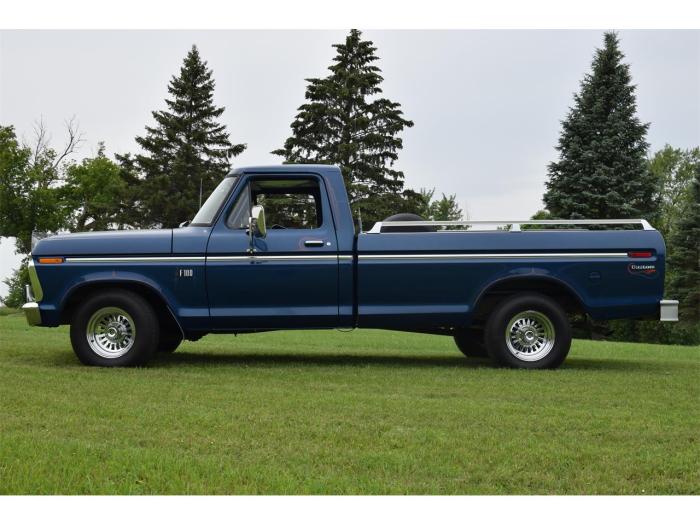
The 1974 Ford F-150 offered a range of powerful engines designed to handle a variety of tasks, from everyday driving to heavy-duty hauling. These engines were known for their durability and reliability, making the F-150 a popular choice for both personal and commercial use.
Engine Options
The 1974 Ford F-150 was available with a selection of gasoline engines, each offering different power outputs and fuel efficiency.
- 302 cubic-inch (4.9L) V8:This engine was the standard option, producing 140 horsepower and 230 lb-ft of torque. It provided adequate power for most everyday tasks, making it a popular choice for those seeking a balance between performance and fuel economy.
- 351 cubic-inch (5.7L) V8:This engine offered more power than the 302, generating 155 horsepower and 270 lb-ft of torque. It was a popular choice for those who required more towing capacity or hauling power.
- 360 cubic-inch (5.9L) V8:This engine was the most powerful option available, producing 170 horsepower and 300 lb-ft of torque. It was often chosen for heavy-duty applications and those requiring maximum power for towing or hauling.
- 400 cubic-inch (6.6L) V8:This engine was available in some models, offering 175 horsepower and 330 lb-ft of torque. It was a powerful engine that provided excellent towing and hauling capabilities.
Fuel Efficiency
Fuel efficiency was a significant consideration for truck buyers in the 1970s, especially with rising fuel prices. The 1974 Ford F-150’s fuel economy varied depending on the engine choice and driving conditions.
The 1974 Ford F150 marked a significant shift in the pickup truck market, offering a blend of ruggedness and practicality. While it was a far cry from the sleek, powerful muscle cars of the era, like the 1966 Ford Galaxie , the F150 carved its own niche, becoming a mainstay for hardworking Americans and a symbol of American ingenuity.
- The standard 302 cubic-inch V8 was generally considered the most fuel-efficient option, offering an estimated fuel economy of around 12-15 miles per gallon (mpg) in city driving and 16-18 mpg on the highway.
- The larger 351 cubic-inch V8 and 360 cubic-inch V8 engines offered slightly lower fuel economy, with estimates ranging from 10-13 mpg in the city and 14-16 mpg on the highway.
- The 400 cubic-inch V8, being the most powerful option, delivered the lowest fuel economy, with estimates around 9-12 mpg in the city and 12-14 mpg on the highway.
Interior and Features
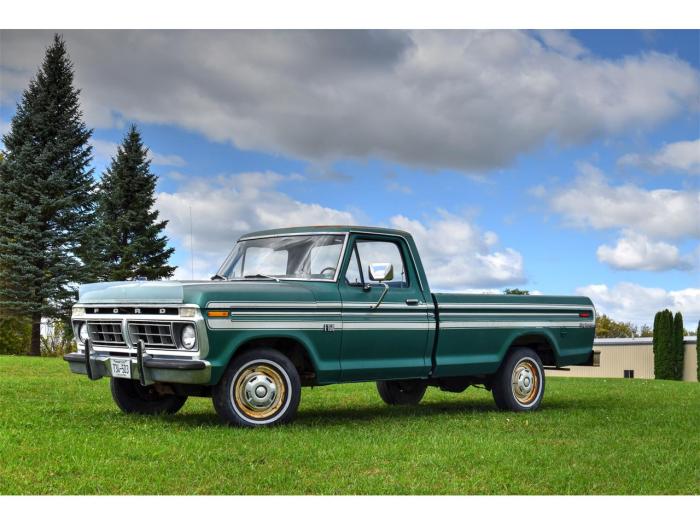
The 1974 Ford F-150’s interior offered a blend of practicality and comfort, reflecting the truck’s workhorse nature while providing a decent level of amenities for its occupants.
Interior Design and Materials
The interior of the 1974 F-150 featured a straightforward design, prioritizing functionality over extravagant styling. The dashboard was characterized by a simple layout with large, easy-to-read gauges. The seats, typically vinyl or cloth, were durable and comfortable, designed to withstand the rigors of everyday use.
The overall feel was robust and utilitarian, reflecting the truck’s intended purpose.
The 1974 Ford F150 was a popular choice for its ruggedness and reliability, but for those seeking a more luxurious ride, the 1971 Ford LTD offered a plush interior and smooth handling. While the F150 was built for work, the LTD was designed for comfort, embodying the spirit of the American luxury car of its era.
Both models, however, reflected Ford’s commitment to quality and innovation, leaving their mark on automotive history.
Standard and Optional Features
The 1974 F-150 came equipped with a range of standard features designed to meet the needs of its target audience. These included:
- A comfortable bench seat for three passengers
- A basic AM radio
- Power steering (optional on some models)
- Power brakes (optional on some models)
- A heater and defroster
Optional features allowed owners to personalize their trucks, adding convenience and comfort. Some of these options included:
- Air conditioning
- Vinyl or cloth upholstery
- A variety of interior trim options
- A rear window defroster
- A tilt steering wheel
Comfort and Practicality
The 1974 F-150’s interior was designed for practicality, with features that made it suitable for both work and leisure activities. The spacious cab provided ample room for passengers and cargo, while the durable materials and simple design ensured long-lasting use.
The large windows offered excellent visibility, enhancing safety and driver confidence. While the interior lacked the sophistication of later models, it provided a comfortable and functional space for drivers and passengers.
Exterior Design and Styling
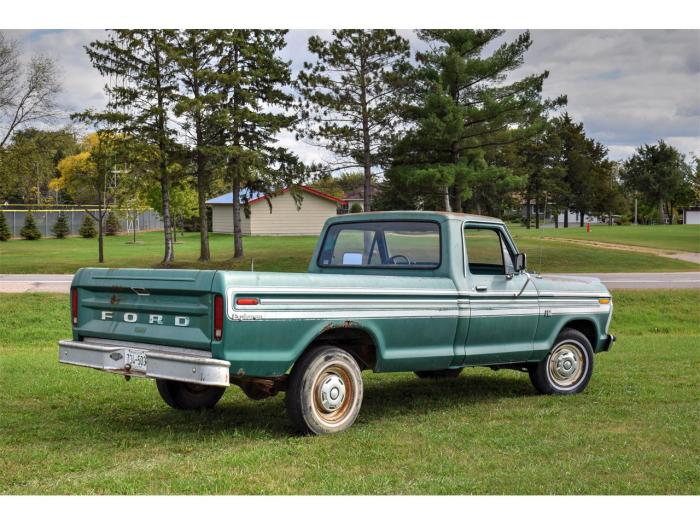
The 1974 Ford F-150 embodied the design trends of its era, showcasing a blend of ruggedness and practicality that appealed to truck buyers. The exterior design reflected the changing times, with a shift towards larger, more imposing vehicles.
Styling Cues of the Era
The 1974 F-150’s styling was heavily influenced by the design trends of the early 1970s. The truck featured a boxy, angular design with sharp lines and a strong, masculine appearance. This style was prevalent in many vehicles of the time, including cars, trucks, and even some household appliances.
- Large, Bold Grille:The F-150 sported a massive, chrome-plated grille with horizontal bars that emphasized its width and presence. This design element was common in trucks of the period, signifying strength and power.
- Square Headlights:The square headlights, often encased in chrome bezels, were a hallmark of the era’s design language. They contributed to the truck’s boxy, functional aesthetic.
- High Beltline:The high beltline, extending along the sides of the truck, added to its robust appearance and provided a sense of security for occupants.
- Chrome Accents:Chrome accents, such as bumpers, side trim, and window surrounds, were popular embellishments on vehicles of the time. They enhanced the truck’s visual appeal and reflected the era’s preference for shiny, polished surfaces.
Comparison to Other Vehicles of the Era
The 1974 F-150’s design shared similarities with other trucks of its time, such as the Chevrolet C/K series and the Dodge D series. These vehicles also featured boxy shapes, large grilles, and square headlights. However, the F-150 stood out with its distinctive grille design, which featured a unique “Ford” script badge.
Safety Features
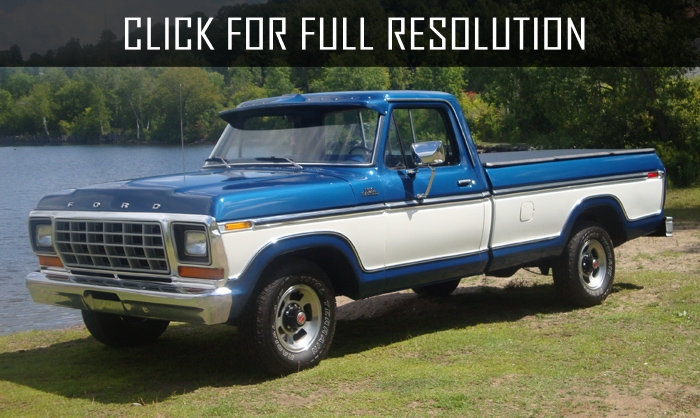
The 1974 Ford F-150, like other vehicles of its era, prioritized durability and functionality over advanced safety features. While it lacked some of the modern safety standards we take for granted today, it did offer some basic safety features that were considered standard for the time.
Safety Features of the 1974 Ford F-150
The 1974 F-150 included a range of safety features that were considered standard for the time, including:
- Standard Safety Equipment: The 1974 F-150 came equipped with a standard set of safety features, including a driver’s side seatbelt, a padded dashboard, and a windshield designed to minimize the risk of injury in the event of a collision.
- Optional Safety Features: Some safety features were optional, including a passenger-side seatbelt, a padded steering wheel, and a front disc brake system. These features were available for an extra cost.
Safety Standards of the Time
The safety standards of the 1970s were significantly different from those of today. While the 1974 F-150 incorporated safety features considered standard for its time, it lacked the advanced safety systems we see in modern vehicles. The National Highway Traffic Safety Administration (NHTSA) had only just begun to implement regulations requiring safety features such as seat belts and padded dashboards in the early 1970s.
The 1974 F-150’s design was largely influenced by these emerging safety standards.
Comparison to Modern Trucks
Modern trucks are equipped with a wide range of advanced safety features, such as:
- Airbags: Modern trucks typically come standard with multiple airbags, including front, side, and curtain airbags, which provide protection in a variety of collision scenarios. The 1974 F-150 did not have airbags.
- Electronic Stability Control (ESC): ESC helps to prevent the vehicle from skidding or rolling over by automatically applying the brakes to individual wheels. This feature was not available in the 1974 F-150.
- Anti-lock Braking System (ABS): ABS helps to prevent the wheels from locking up during braking, allowing the driver to maintain steering control. While ABS was available as an option in some vehicles in the 1970s, it was not a standard feature in the 1974 F-150.
- Backup Camera: Backup cameras provide drivers with a rearward view to help prevent accidents while backing up. This feature was not available in the 1974 F-150.
- Blind Spot Monitoring: Blind spot monitoring systems use sensors to detect vehicles in the driver’s blind spot and alert the driver. This feature was not available in the 1974 F-150.
- Lane Departure Warning: Lane departure warning systems use sensors to detect when a vehicle is drifting out of its lane and alert the driver. This feature was not available in the 1974 F-150.
- Adaptive Cruise Control: Adaptive cruise control systems automatically adjust the vehicle’s speed to maintain a safe distance from the vehicle in front. This feature was not available in the 1974 F-150.
Production and Sales: 1974 Ford F150
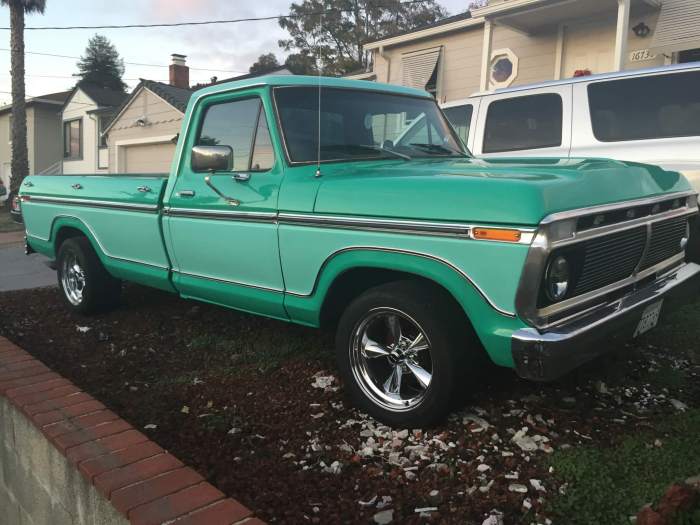
The 1974 Ford F-150 was a popular and successful model, and its production and sales figures reflect its popularity.
Ford produced a substantial number of F-150s in 1974, reflecting the strong demand for pickup trucks in the American market. While precise figures for the 1974 model year are not readily available, it’s important to note that the F-Series trucks, including the F-150, were already a major force in the market by the mid-1970s.
The 1974 Ford F150 marked a significant shift in the pickup truck market, moving towards a more modern and powerful design. While it may seem worlds apart from the classic, streamlined look of a 1940 Ford Business Coupe , both vehicles share a common thread – they represent Ford’s commitment to innovation and adapting to the changing needs of their customers.
The 1974 F150 was a workhorse built for the evolving demands of the American landscape, much like the Business Coupe was a symbol of sleek efficiency in its time.
Sales Figures and Market Reception, 1974 Ford F150
The 1974 F-150 was well-received by consumers, contributing to its strong sales performance. The truck’s combination of ruggedness, versatility, and affordability made it a popular choice for a wide range of buyers.
Factors Contributing to Success
Several factors contributed to the success of the 1974 Ford F- 150. These factors include:
- Strong Reputation:Ford’s F-Series trucks had already established a reputation for durability and reliability, which carried over to the 1974 F-150.
- Versatility:The F-150’s versatility made it suitable for a wide range of applications, from work trucks to personal vehicles.
- Affordability:The 1974 F-150 was priced competitively, making it accessible to a broad range of buyers.
- Engine Options:Ford offered a variety of engine options, giving buyers the choice of power and fuel efficiency.
- Marketing and Advertising:Ford’s effective marketing and advertising campaigns helped to raise awareness of the F-150’s features and benefits.
Legacy and Impact
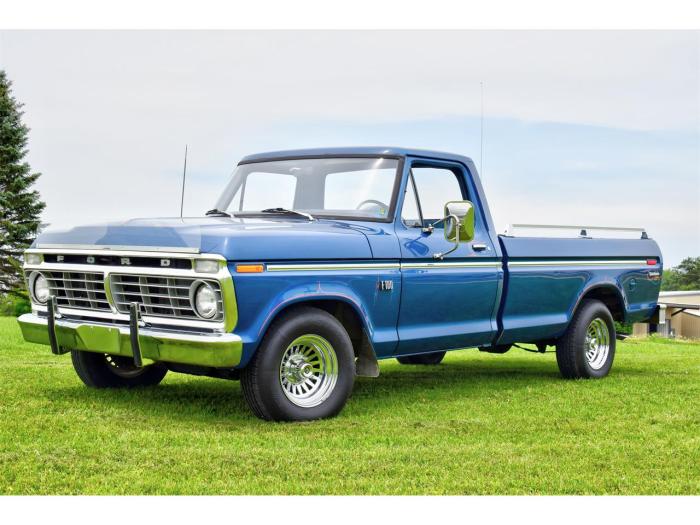
The 1974 Ford F-150 played a significant role in shaping the truck market and establishing the F-Series as a dominant force. Its introduction marked a pivotal moment in the evolution of pickup trucks, paving the way for the modern trucks we see today.
Contributions to the Evolution of the F-Series
The 1974 F-150 was instrumental in the evolution of the F-Series in several ways:* The introduction of the F-150 nameplate:This marked a shift from the previous “F-100” designation, signifying a new era for Ford’s pickup trucks.
Enhanced capabilities
The 1974 F-150 offered increased payload and towing capacities, making it a more capable workhorse for various tasks.
Improved comfort and features
The 1974 model introduced a more refined interior with enhanced comfort features, making it more appealing to both work and personal use.
New engine options
The availability of powerful V8 engines, including the 460 cubic-inch V8, further enhanced the F-150’s performance and capabilities.These improvements established the F-150 as a more versatile and appealing pickup truck, solidifying its position as a leader in the market.
Ending Remarks
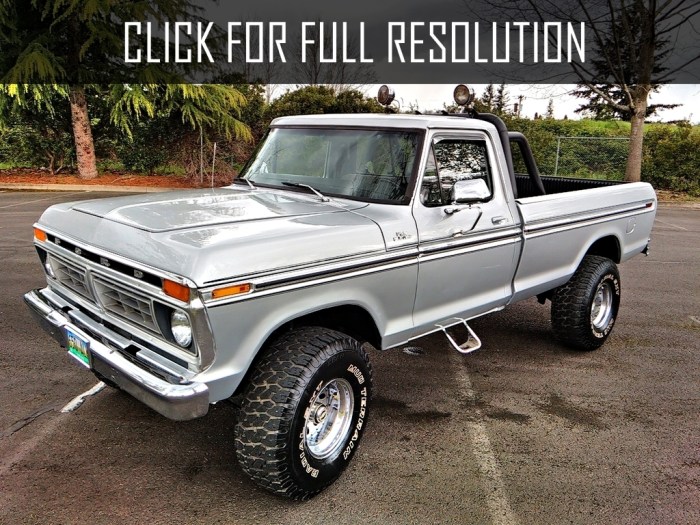
The 1974 Ford F150 stands as a testament to the enduring legacy of the F-Series. Its introduction marked a significant step in the evolution of the truck, introducing new design elements, powertrain options, and features that would define future generations.
While the 1974 F150 may be considered a vintage truck today, its impact on the automotive landscape remains undeniable. Its influence can be seen in the modern F-Series, a line of trucks that continues to set the standard for performance, durability, and innovation.